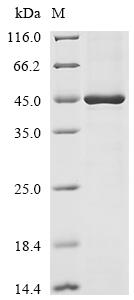Recombinant Human Protein flightless-1 homolog (FLII) is produced in E. coli and contains amino acids 495 to 827. This partial protein comes engineered with an N-terminal 10xHis-tag and a C-terminal Myc-tag, which helps with purification and detection. The product shows a purity greater than 85% as evaluated by SDS-PAGE, suggesting good quality for research applications. It's designed for research use only and is not intended for diagnostic or therapeutic purposes.
Flightless-1 homolog (FLII) appears to be a multifunctional protein involved in various cellular processes, including actin remodeling and gene transcription regulation. It likely plays an important role in cytoskeletal organization and cellular signaling pathways, making it a potentially significant protein for studying cell motility and differentiation. Researchers often examine FLII in developmental biology contexts and cellular responses to environmental changes.
Potential Applications
Note: The applications listed below are based on what we know about this protein's biological functions, published research, and experience from experts in the field. However, we haven't fully tested all of these applications ourselves yet. We'd recommend running some preliminary tests first to make sure they work for your specific research goals.
Based on the provided information, the recombinant human FLII fragment is expressed in E. coli, a prokaryotic system that is generally unsuitable for producing properly folded eukaryotic proteins with complex domain structures like FLII. FLII contains multiple functional domains, including gelsolin-like domains that require precise folding and potential post-translational modifications for their roles in actin remodeling. The expressed fragment (495-827aa) represents only a partial region of the full-length protein and contains dual tags (N-terminal 10xHis and C-terminal Myc) that may interfere with proper folding. E. coli lacks the eukaryotic chaperones and modification machinery necessary for the correct folding of complex eukaryotic proteins. Since activity is unverified, the protein cannot be assumed to be correctly folded or bioactive without experimental validation of its structural integrity and functional properties.
1. Protein-Protein Interaction Studies Using Pull-Down Assays
The dual tags enable technical feasibility for pull-down assays. Still, if the FLII fragment is misfolded (as likely in E. coli), it will not interact physiologically with true binding partners. The gelsolin-like domains require precise conformation for specific actin-binding interactions. Identified interactions could be non-physiological artifacts. This application should not be pursued without confirmation of proper folding through biophysical characterization.
2. Antibody Development and Validation
The recombinant FLII fragment can serve as an effective immunogen for generating antibodies that recognize linear epitopes within the 495-827aa region, even if the protein is misfolded. The dual tags facilitate purification and detection. However, antibodies may not recognize conformational epitopes of native, properly folded FLII in human cells. Validation against full-length FLII from mammalian expression systems is essential.
3. Biochemical Characterization and Stability Studies
This application is well-suited for assessing the recombinant product itself. Techniques like circular dichroism spectroscopy, size-exclusion chromatography, and thermal shift assays can evaluate the FLII protein's folding state, oligomerization, and stability. These studies are valuable even if the protein is inactive, as they characterize the recombinant product and can inform about its suitability for other applications.
4. ELISA-Based Detection System Development
This application is feasible for technical development but has significant limitations. The tags enable ELISA format development, but if the FLII fragment is misfolded, the assay may not accurately detect native FLII in biological samples. This application should be limited to tag-based detection and requires validation against properly folded FLII for reliable biological quantification.
Final Recommendation & Action Plan
Given the high probability of misfolding in E. coli for this complex eukaryotic protein fragment, we recommend first performing a comprehensive biophysical characterization to assess folding quality. This should include circular dichroism spectroscopy for secondary structure analysis and size-exclusion chromatography with multi-angle light scattering for oligomeric state assessment. Antibody development can proceed immediately as the safest application. Avoid all functional studies (interactions) until proper folding is validated. For reliable FLII functional studies, obtain full-length protein from mammalian expression systems capable of proper folding and post-translational modifications. Always include appropriate controls, such as native FLII from human cell extracts, when possible.




